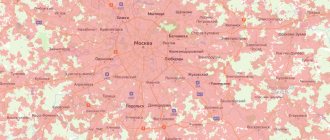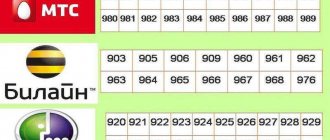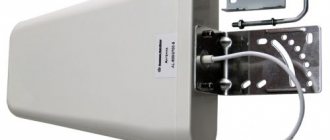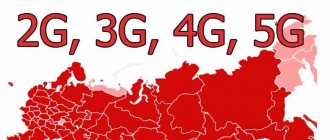GSM-Repeters.RU » How to determine the cellular frequency using a smartphone
When choosing an amplification system, it is extremely important to know two parameters: the generation of the mobile network (2G, 3G or 4G) whose quality you want to improve, and the frequency at which it operates.
The fact is that all the main components of amplification systems - antennas, repeaters, modems and routers - are created for specific frequency ranges and very rarely support all existing standards in the world at once. In other words, you can buy a booster kit “for 4G Internet,” but if it includes an antenna designed for a frequency range that your operator does not operate in, the money will be wasted.
Let's give an example. Most often, 4G Internet is provided at a frequency of 2600 MHz, and most 4G booster kits are designed for this frequency. However, increasingly, domestic operators are starting to use additional frequencies of 1800 and 800 MHz. If this is the network in your location, then a kit designed for a frequency of 2600 MHz will be useless.
So, to choose a kit, you need to know which technologies you want to amplify and in which frequency ranges they operate. The easiest way to do this is using a smartphone running the Android or iOS (iPhone) operating system.
5G frequency bands
| Band | Uplink | Downlink | Duplex |
| n1 | 1920 – 1980 MHz | 2110 – 2170 MHz | FDD |
| n2 | 1850 – 1910 MHz | 1930 – 1990 MHz | FDD |
| n3 | 1710 – 1785 MHz | 1805 – 1880 MHz | FDD |
| n5 | 824 – 849 MHz | 869 – 894 MHz | FDD |
| n7 | 2500 – 2570 MHz | 2620 – 2690 MHz | FDD |
| n8 | 880 – 915 MHz | 925 – 960 MHz | FDD |
| n20 | 832 – 862 MHz | 791 – 821 MHz | FDD |
| n28 | 703 – 748 MHz | 758 – 803 MHz | FDD |
| n38 | 2570 – 2620 MHz | 2570 – 2620 MHz | TDD |
| n41 | 2496 – 2690 MHz | 2496 – 2690 MHz | TDD |
| n50 | 1432 – 1517 MHz | 1432 – 1517 MHz | TDD |
| n51 | 1427 – 1432 MHz | 1427 – 1432 MHz | TDD |
| n66 | 1710 – 1780 MHz | 2110 – 2200 MHz | FDD |
| n70 | 1695 – 1710 MHz | 1995 – 2021 MHz | FDD |
| n71 | 663 – 698 MHz | 617 – 652 MHz | FDD |
| n74 | 1427 – 1470 MHz | 1475 – 1518 MHz | FDD |
| n75 | N/A | 1432 – 1517 MHz | SDL |
| n76 | N/A | 1427 – 1432 MHz | SDL |
| n77 | 3.3 – 4.2 GHz | 3.3 – 4.2 GHz | TDD |
| n78 | 3.3 – 3.8 GHz | 3.3 – 3.8 GHz | TDD |
| n79 | 4.4 – 5.0 GHz | 4.4 – 5.0 GHz | TDD |
| n80 | 1710 – 1785 MHz | N/A | SUL |
| n81 | 880 – 915 MHz | N/A | SUL |
| n82 | 832 – 862 MHz | N/A | SUL |
| n83 | 703 – 748 MHz | N/A | SUL |
| n84 | 1920 – 1980 MHz | N/A | SUL |
| n85 | 2496 – 2690 MHz | N/A | SUL |
| n257 | 26.5 – 29.5 GHz | 26.5 – 29.5 GHz | TDD |
| n258 | 24.25 – 27.5 GHz | 24.25 – 27.5 GHz | TDD |
| n260 | 37 – 40 GHz | 37 – 40 GHz | TDD |
Upper and lower frequencies
From a financial point of view, the development of LTE networks at lower frequencies (less than 2000 MHz) is most profitable for operators. Such frequencies penetrate buildings better, but are not able to provide high-speed connections to areas with high population density.
The functions of the upper frequencies are opposite to the functions of the lower ones, so the best option for a high-quality connection is a combination of both frequency channels, which allows you to get rid of “shadow” areas over large spaces.
Also in megacities, there is a tendency to install special devices on the roofs of office buildings to facilitate the spread of high-speed networks indoors.
2G/3G/4G frequencies in Russia
This picture shows the distribution of frequencies from 450 to 2700 MHz by operators with the designation ARFCN. The distribution of 900 and 1800 MHz is indicated for the Moscow region, the remaining ranges are federal, i.e. the same for all regions.
Individual distribution of the 900 MHz range between operators in Russian regions.
Individual distribution of the 1800 MHz range between operators in Russian regions.
| Standard name | Frequency ranges | Icon on the phone | Possible designations of operating ranges in phones and programs | Range of values for ARFCN, UARFCN or EARFCN |
| GSM-900 (2G) | 900 MHz (Band  | E, G, no icon | GSM900, EGSM900, Band 8 | 0.. 124 |
| GSM-1800 (2G) | 1800 MHz (Band 3) | E, G, no icon | GSM1800, DCS, DCS1800, Band 3, Band 4 | 512.. 885 |
| UMTS-900 (3G) | 900 MHz (Band  | 3G, H, H+ | UMTS900, Band 8 | 2937.. 2712 |
| UMTS-2100 (3G) | 2100 MHz (Band 1) | 3G, H, H+ | UMTS2100, WCDMA2100, Band 1 | 10562.. 10838 |
| LTE-800 (4G, LTE) | 800 MHz (Band 20) | 4G, LTE | 800MHz, Band 20 | 6150.. 6449 |
| LTE-1800 (4G, LTE) | 1800 MHz (Band 3) | 4G, LTE | LTE1800, DCS, DCS1800, Band 3, Band 4 | 1200.. 1949 |
| LTE2600 FDD (4G, LTE) | 2600 MHz (Band 7) | 4G, LTE | LTE2600, Band 7 | 2750.. 3449 |
| LTE2600 TDD (4G, LTE)** | 2600 MHz (Band 38) | 4G, LTE | Band 38 | 37750.. 38249 |
You can read how to choose a cellular amplifier HERE.
Measuring signal levels and frequencies of GSM, 3G, 4G using an IPhone.
Measuring signal levels and frequencies of GSM, 3G, 4G using Android version 7.0 and higher.
Determining the generation of the cellular network
Determining the generation of a cellular network using a smartphone is usually very easy. In most modern operating systems, the data technology is indicated in the status bar next to the cellular signal strength. The technology can be specified directly (2G, 3G or 4G) or using one of the abbreviations. The most common designations are:
- 2G, GPRS (G), EDGE (E) - traditional 2G technology, which runs standard GSM voice communications and slow mobile Internet;
- 3G, UMTS, HSDPA (H), HSPA+ (H+) - the third generation of cellular communications used for calls and access to broadband mobile Internet;
- 4G, LTE (L) is the fourth generation of cellular communications, currently used by domestic operators only for access to high-speed mobile Internet.
For example, on Xiaomi smartphones with dual SIM cards, the status bar looks like this:
It is easy to determine that the first SIM card of the MTS operator is currently operating in 4G mode, and the second SIM card of Tele2 is in 3G mode.
Comments
- 4G potentially operates in all frequency ranges - 800, 900, 1800, 2100, 2600 MHz.
- LTE Band 38 (2600 TDD) is used by Megafon and MTS operators only in Moscow. Repeaters for it exist, but in fact, there is no point in it.
- Yota is the virtual operator Megafon, i.e. Where there is Megafon, there is also Yota.
- LTE Band 7 (2600 MHz) is used only in cities.
- LTE Band 3 (1800 MHz) has the fastest Internet in rural areas.
- LTE Band 20 (800 MHz) – low speed, but the longest range from the base station. This picture at the top of the page shows the distribution of frequencies from 450 to 2700 MHz by operators with the designation ARFCN. The distribution of 900 and 1800 MHz is indicated for the Moscow region, the remaining ranges are federal, i.e. the same for all regions.
Further development of LTE
“Real” 4G should provide data transfer speeds of up to 1Gbps. But the first LTE standard clearly did not reach these figures. It took another half a decade to reach this value. This is how the LTE Advanced (4G+) standard appeared. The increase in speeds was achieved due to:
- modernization of data package packaging technology;
- increasing signal bandwidth;
- using several transmitters to work with one subscriber.
You can see a coverage map of communication networks of all standards in your city on the website of the Ministry of Telecom and Mass Communications.
Since the official announcement of the creation of the technology to this day, active work has been carried out to make data transfer faster. Over the past 11 years, many solutions have been implemented. But in the future, LTE is still inferior to 5G, because it cannot withstand the increasing flow of technical means.
Which ranges are better - high-frequency or low-frequency
The lower the frequency, the wider its coverage and better cross-country ability. This gives the user the opportunity to connect to the Internet with a high-quality connection in various remote corners or surrounded by high-rise buildings (and even in the high-rise buildings themselves) in megacities. But such a connection has a lower data transfer rate than high-frequency bands.
For cellular operators, low frequencies (up to 2,000 MHz) are a more profitable solution due to the opportunity to save on equipment. In large cities they are usually used. For the best coverage, the most sophisticated operators combine high and low frequencies. These include, for example, Megafon, MTS, Beeline.
High-frequency bands have higher data transfer speeds, but such towers have a smaller coverage area and wave penetration. They are better suited for open spaces such as suburbs.
On what basis are frequencies distributed between operators?
In the Russian Federation, only 3–4% of frequency ranges are occupied by civil organizations, which include telecom operators. The rest is distributed between military and public needs.
In Russia, the distribution of radio frequencies is handled by the organization GKRC (State Commission on Radio Frequencies). The telecom operator must apply to use the frequency range of interest. Interestingly, there is no exact data on the frequencies used in the public domain. The applicant will receive information about whether the band is free or not only after reviewing the application (which, by the way, is paid).
The application is being considered by SCRF employees, law enforcement agencies and Roskomnadzor. Each of them may refuse to provide frequencies (the security forces may not even name the reason, citing the secrecy of the data).
If several operators apply for the same resource at once, then the SCRF announces a competition. Points are awarded for using technology and having the right equipment. Whoever scored the most received the right to buy the frequency.
Is 4G Beeline connected on your mobile phone?
To answer this question and determine the bands number of your operator, the user of a device with mobile communications needs to use the technical menu.
Necessary conditions for receiving 4G format from a Beeline client:
- Have a modern model of smartphone or other mobile device with Internet access.
- Connect at the company office to a Beeline number with high-speed (you can have unlimited) Internet (for example, “Everything” from a mobile operator).
- Exchange your old SIM card for a modern one when connecting to a new tariff.
Expert opinion
Andrey
Beeline salon employee. 5 years in the company. Knows everything about Beeline services and tariffs.
As soon as the subscriber makes a purchase and inserts a SIM card into the device, the Beeline system will immediately register it in its network and automatically configure the 4G format.
The client needs to respond positively to the system’s connection request, and he can use high-speed Internet.
If during the operation of smartphones on the Android or iOS platforms the settings have failed, you can restore them:
- independently, manually specifying the required positions in the phone;
- by coming to any of the Beeline offices, where qualified assistance will be provided by managers.
To configure it yourself, the subscriber needs to know all the details of his cellular operator.
Example of settings by graphs:
- Enter the “Network name” (in English): Beeline Internet.
- Fill in (or select from the list) the “APN” column: internet.beeline.ru.
- The next one is “Username” (in Latin): Beeline.
- “Password” (in Latin): Beeline.
- Select from the proposed “Authentication Type”: PAP.
- Next – “APN Type”: default.
- The last one is “APN Protocol”: IPv4.
Then in the device settings you need to find the section regarding mobile communications:
- On Android: in Settings, select Mobile Network.
- If the subscriber has iOS, then “Cellular”.
- In the subsections, choose from a list of proposed formats: LTE or 4G.
What are frequency ranges
The entire spectrum of frequencies was divided into bands by the international organization 3GPP. There are only 72 of them, but many of them are inaccessible to the average user and are used for government needs.
Frequency bands (or radio bands) are used not only for mobile Internet access, but also for other purposes:
- TV;
- broadcasting;
- military communications;
- walkie-talkies
They use different bands so that the signals from the devices do not interfere with each other.
In relation to the mobile Internet, frequency ranges may vary depending on the telecom operator and data transmission standard (3G or LTE). In Russia, several sections from 300 to 3,000 MHz have been allocated for these needs. The same radio bands are used for GSM mobile communications.
Theoretically, all of them can be used to transmit data using the fourth generation standard and LTE, but in practice this is not entirely true. The new technology does not immediately replace the old one, and therefore some frequencies are legally assigned to 3G Internet.
Frequent problems and solutions
In most cases, there are no difficulties with setup, because the transition to 4G or 4G+ occurs automatically. The same is true when installing a new supporting SIM card. The most common problem is lack of device support. To date, not all models support 4G+ technology. It is relevant for the following smartphones:
- Samsung Galaxy Alpha (SM-G850F), Galaxy S6 (SM-G920F) – B7, B20, Note Edge (SM-N915F) and Galaxy S6 Edge (SM-G925F) – B7, B20.
- Huawei - Honor 6 (H60-L04) and Ascend Mate 7 (MT7-L09).
Also, when setting up LTE on Beeline, make sure that the data is entered correctly, check whether the SIM card supports it and select the required network in the mobile device settings. Try restarting the device or call the operator for advice by calling 0611.
In the comments, tell us if you were able to set up LTE on Beeline, what difficulties arose when solving this issue, and how you managed to solve them.
4G speed
It is worth understanding that the actual connection speed almost always differs from the nominal one. The theory does not take into account factors such as landscape, remoteness of cell sites, or the presence of the user in the building - such conditions interfere with the connection and significantly reduce its quality.
The speed of data transfer also depends on the operator’s workload: the more users have access to fourth-generation networks, the lower the speed indicators. The speed of the Internet connection in wireless networks is determined by the width of the frequency range, as well as the implementation of the communication duplex.
These specifications vary by operator. Although some providers guarantee 300 Mbit/s, the average actual speed is only 75 Mbit/s (Tele2, MTS and Beeline).
The already mentioned tandem of Beeline and Megafon recently began the transition to the LTE-advanced standard, which made it possible to increase speed to 160 Mbit/s in some coverage points.
Now such a standard is presented in Moscow and St. Petersburg, but the regions will have to wait a long time for it: the total distribution of 4G+ throughout Russia is now impossible for two reasons.
The first is the cost of the required equipment, and the second (follows from the previous one) is that as the coverage area increases, the load on existing cell towers will increase, that is, the average speed will only decrease.
Since the speed of the connection depends on the width of the frequency range, we can say that today Megafon is in the most advantageous position, which, after absorbing Yota, added channels of the acquired company to its own frequencies.
Theoretically, the Megafon network can operate on a 40 MHz channel and accelerate in FDD mode to 300 Mbit/s, but since part of the channel is given to subscribers of the subsidiary Iota, the actual speed is approximately 100 Mbit/s.
If we compare networks of the third and fourth generations, the latter have several times higher speeds: an average of 80 Mbit/s versus a maximum of 3 Mbit/s. HSPA+ was able to overclock 3G to 45 Mbps, but these figures still lag behind 4G.
History of the emergence of RF communications: frequencies
In 1983, the development of a European digital communications standard began. We remind you that the first generation of 1G used analog transmission. Thus, engineers developed the standard in advance, anticipating the history of technology development. Digital communications were born out of World War II, or more precisely, the Green Hornet encrypted transmission system. The military understood perfectly well: the era of digital technology was coming. Civil industry caught the movement of the wind.
Cellular frequency
900 MHz
The European organization CEPT has created the GSM (Groupe Special Mobile) committee. The European Commission has proposed using the 900 MHz spectrum. The developers settled in Paris. Five years later (1987), 13 EU countries submitted a memorandum to Copenhagen on the need to create a unified cellular network. The community decided to request GSM's help. The first technical specification was released in February. Politicians from four countries (May 1987) supported the project with the Bonn Declaration. The next short period (38 weeks) is filled with general bustle, controlled by four appointed persons:
- Armin Silberhorn (Germany).
- Philippe Dupoulis (France).
- Renzo Failli (Italy).
- Stephen Temple (Great Britain).
In 1989, the GSM Commission leaves the trusteeship of CEPT, becoming part of ETSI. On July 1, 1991, the former Prime Minister of Finland, Garry Holkeri, made the first call to a subscriber (Kaarina Suonio) using the services of the Radioline provider.
1800 MHz
In parallel with the introduction of 2G, work was underway to utilize the 1800 MHz region. The first network covered the UK (1993). At the same time, the Australian operator Telecom moved in.
1900 MHz
The frequency of 1900 MHz was introduced by the USA (1995). The GSM Association was created, the world number of subscribers reached 10 million people. A year later, the figure had increased tenfold. The use of 1900 MHz prevented the introduction of the European version of UMTS.
800 MHz
The 800 MHz band appeared in 2002, parallel to the introduction of multimedia messaging service.
What networks does Tele2 support in Moscow and the Moscow Region?
yanixxx, I wouldn’t be surprised that in 250-02. When I was on the iota, my devices (windowphones) unsuccessfully tried to connect to LTE 250-02, if 250-11 is missing. A lot of time (like, more than six months) after I left them, they still reported to the media that they had fixed the problems that arose because of this, but I never went back to them. So I didn't check it like now.
(read more…)
LTE: B3(1800) 10MHz (EARFCN 1596, UL 1749.6MHz, 1844.6MHz) MIMO 1×1 (SISO) B7(2700) 20MHz+20MHz (EARFCN 2850, EARFCN 3048) MIMO 1×1 (SISO)
Where to find Beeline 4G LTE base stations
Information about the coverage area in graphical form is published on the official website of the mobile operator. For the convenience of users, they are located on an interactive map. You can search by address by zooming accordingly.
The 4G network is displayed in brick color - Moscow, according to Beeline, network distribution in the metro is 100%.
There are no marks indicating the exact location of the base stations. This data is a trade secret. Approximate coordinates can be found using a special service that generates a selection from the general database of the maximum number of registered subscribers.
To receive information, you must indicate the following codes in the request form on the website:
- user mobile device;
- terrain;
- countries;
- cellular operator networks.
A similar search can be done automatically using NetMontor or another application.
How to check if LTE is connected
To search for information, open the thematic section “Network mode” in the “Settings” menu.
Checking the LTE connection - when you enter the number, a menu with data opens immediately on the smartphone screen.
In certain versions of the Android shell, the user can set the preferred option:
- LTE;
- GSM;
- WSDMA.
By fixing the mode, channel switching is eliminated to stabilize communication in difficult conditions.
You can clarify the data using the engineering menu using the following algorithm (example of actions with a Samsung smartphone):
- turn off the Wi-Fi connection in the “curtain” or in “Settings”;
- indicate the network mode “LTE only”;
- dial the code *#0011#.
In the window that opens, the frequency band value is indicated in the Frequency position.
Additional information on the screen helps you evaluate the quality of the connection. At low signal strength (worse than 120 dB), the stability of the connection is disrupted. Similar disadvantages appear if the noise level exceeds the amplitude of the useful signal (CINR<0).
Megafon coverage area
- 2G allows you to transmit voice information, has low speed, GPRS, EDGE.
- 3G provides access to the network at high speed.
- 4G – high-speed LTE Internet, the speed of which reaches 150 MB. /sec.
- 4G+ is supported only in Moscow, the Moscow region, St. Petersburg and Ufa, and the speed in this LTE standard reaches 300 Mb/sec.
The Megafon operator introduces modern technologies into its work, increases its network coverage area, and teams up with large communications concerns for full-fledged operation for the benefit of its subscribers.
Genealogy of standards
The following information is intended to explain to the average person the structure of existing, extinct standards. Below, in the following sections, the technologies used in Russia will be described. The corresponding representatives of the tree that decorated the Russian forest are marked in bold.
1G
- AMPS family: AMPS, NAMPS, TACS, ETACS.
- Others: NMT, C-450, DataTAC, Hicap, Mobitex.
2G: 1992
- GSM/3GPP family: GSM, HSCSD, CSD.
- 3GPP2 family: cdmaOne.
- AMPS family: D-AMPS.
- Other: iDEN, PHS, PDC, CDPD.
2G+
- 3GPP/GSM family: GPRS, EDGE.
- 3GPP2 family: CDMA2000 1x, including Advanced.
- Others: WiDEN, DECT.
3G: 2003
- 3GPP family: UMTS.
- 3GPP2 family: CDMA2000 1xEV-DO R.0
3G+
- 3GPP family: LTE, HSPA, HSPA+.
- 3GPP2 family: CDMA2000 1xEV-DO R.A, CDMA2000 1xEV-DO R.B, CDMA2000 1xEV-DO R.C
- IEEE Family: Mobile WiMAX, Flash OFDM.
4G: 2013
- 3GPP family: LTE-A, LTE-S Pro.
- IEEE family: WiMAX.
5G: 2020
- LTE.
- 5G-NR.
Short description
Genealogy allows you to trace extinct species. For example, modern authors often use the abbreviation GSM, misleading the reader. The technology is entirely limited to the second generation of cellular communications, an extinct species. The previous frequencies with additions continue to be used by descendants. On December 1, 2016, Australia's Telstra stopped using GSM, becoming the first operator in the world to completely upgrade its equipment. Technology continues to be used by 80% of the world's population (according to the GSM Association). The American AT&T followed the example of its Australian colleagues on January 1, 2017. The service was stopped by the Optus operator; on April 2021, Singapore recognized the inadequacy of 2G to the growing needs of the population.
So, the term GSM is used in relation to outdated equipment that has overwhelmed the Russian Federation. The descendant protocols can be called successors of GSM. The frequencies are preserved by subsequent generations. The punctures and methods of transmitting information are changing. The frequency allocation aspects that accompany equipment upgrades are discussed below. Information is required to establish the GSM relationship.
Basic LTE modes
The LTE standard is divided into two types: TDD and FDD.
The first implies temporal (from the English Time) division of the signal, and the second - frequency (from the English Frequency). FDD is a more convenient communication mode because, from the point of view of everyday use, it is more stable.
The difference between these concepts lies in the method of loading and unloading data. Thanks to FDD, parallel processing of incoming and outgoing Internet traffic occurs.
Imagine that a user is watching a video on YouTube and at the same time uploading an entire album of photos to the cloud storage. Watching a video will be considered a download operation, and sending a photo will be an upload, and in FDD mode the gadget distributes both operations over different frequency channels.
For example, LTE from the Russian Megafon operates at a frequency of 17 MHz, 11 of which can be used for downloading content, and the remaining 6 for uploading.
Separate traffic processing increases the stability of the speed of each individual process, thereby ensuring a better connection.
TDD processes traffic sequentially. In other words, over the same 17 MHz, both downloading and uploading of data will be carried out - but without separation, but alternately in one channel. The disadvantage of this mode is possible “jumps” in speed.
Currently, Russian cellular operators are striving to combine the operation of TDD and FDD stations. By combining modes into one network, providers increase the overall connection speed.
Checking frequency via USB modem
It is worth emphasizing that those users who want to check the Tele2 4g frequency via a modem should use the device interface. The exact procedure depends on the model of the device you choose, but in general it will require the following steps:
- First of all, you need to open the settings section;
- here you should select the tab that mentions diagnostics or signal information;
- after which all that remains is to find the RSSI item or the signal level at which the network should operate.
In addition, there are special utilities that help make measurements, but given the presence of the necessary functionality in the modem itself, their use is not necessary.











